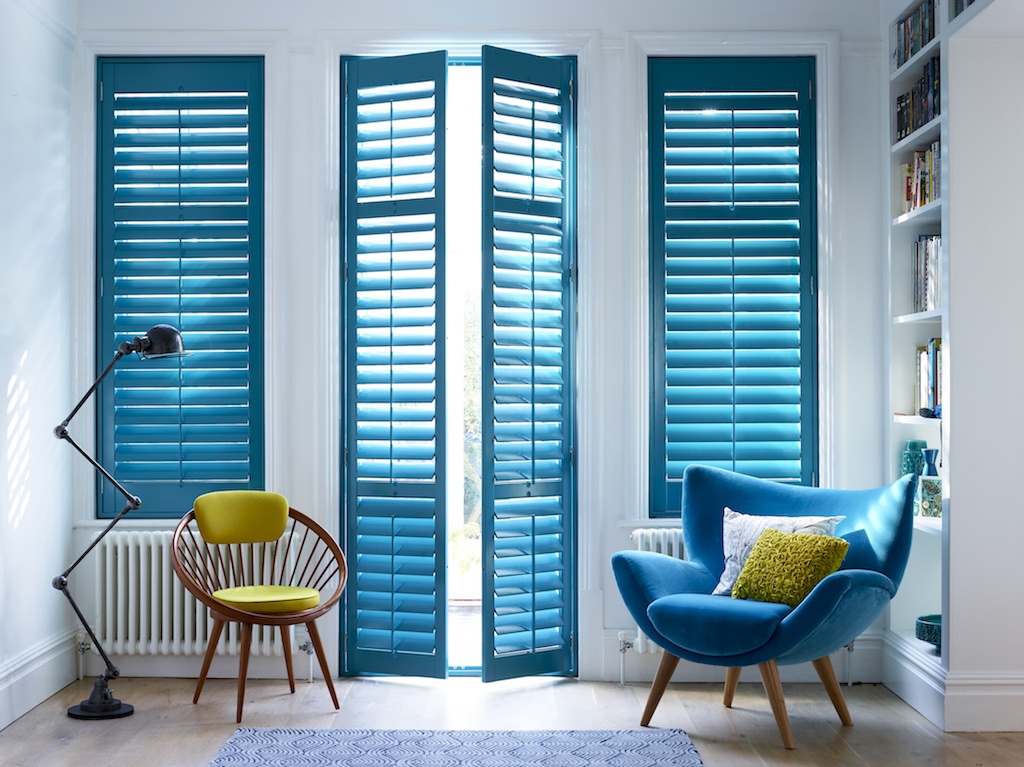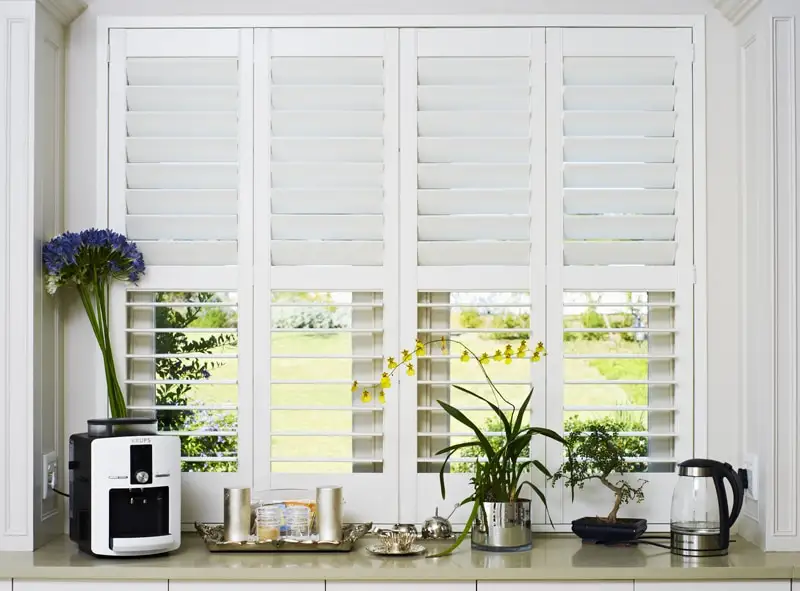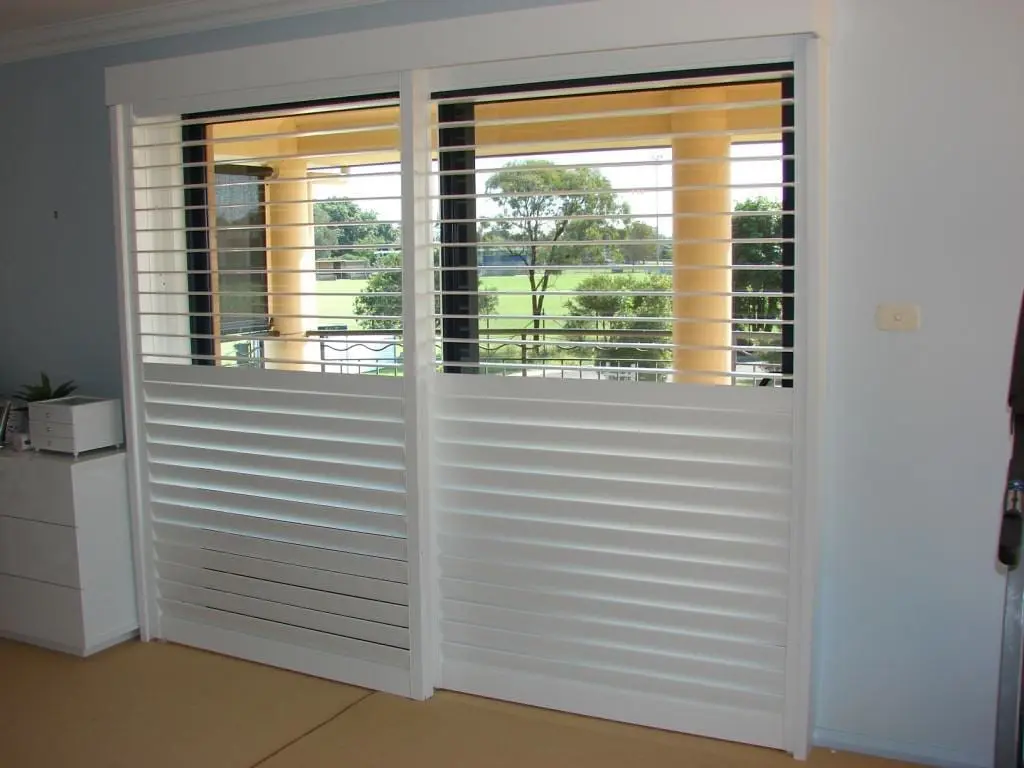In this guide, we’ll walk you through everything you need to know about selecting the perfect shutters for your patio or French doors. We will cover various types, materials, and styles of shutters. Additionally, we’ll discuss installation and maintenance tips to help you make the best choice for your home.

Introduction
Shutters were once a purely functional feature in homes. They have now evolved into a design element that marries both aesthetics and utility. They are not just about shielding your home from the elements! Shutters also add a decorative touch. This enhances the beauty of the patio and French doors.
If you’re looking for privacy, shutters can provide an effective barrier while adding charm to your home. They also offer excellent sun control, helping to manage natural light and temperature.
Beyond functionality, shutters serve as a stylish way to enhance your home’s exterior.
First, Let’s discuss why you should choose shutters for your patio and french doors.
Why Choose Shutters for Your Patio and French Doors?
Shutters are more than just a design trend. They provide various advantages, making them an excellent choice for patio and French doors. First, they offer control over the amount of light and air entering your home. This allows you to adjust these elements to your preference. As a result, you can create the perfect atmosphere for any situation. Additionally, shutters provide privacy.
They act as a physical barrier to prying eyes. You can have protection without sacrificing style! Shutters can help improve your home’s energy efficiency. They act as an extra layer of insulation, protecting
Homeowners often overlook these functional benefits, focusing on aesthetic appeal alone. Shutters are visually charming and add to the aesthetic appeal of your home. They also offer practical benefits like privacy, sun control, and insulation. This combination of style and function makes them a wise investment.
Types of Shutters
1. Hinged Shutters

Hinged shutters are the most traditional and widely recognized type. These shutters are attached to the sides of the door frame using hinges, allowing you to swing them open and close like regular doors. Hinged shutters offer versatility in design, ranging from more ornate, decorative options to more straightforward, more minimalist looks.
They can come in several styles, including:
- Raised Panel: These shutters feature a raised center panel, adding depth and texture to the design. Raised panel shutters suit homes with a traditional or colonial aesthetic.
- Flat Panel: As the name suggests, flat panel shutters have smooth, flat panels, making them a good fit for contemporary or minimalist homes.
- Louvered: Louvered shutters feature adjustable horizontal slats that allow you to control light and airflow. They offer flexibility in managing how much sunlight enters your home.
Hinged shutters are ideal if you prefer easy access to the doors behind them. They can open wide, allowing you to use your doors for entry and exit fully.
2. Bypass Shutters

Bypass shutters are a more modern and space-efficient option, especially for large doorways. Unlike hinged shutters, bypass shutters do not swing outward. Instead, they feature panels that slide past one another along a track, similar to sliding glass doors. This makes them an excellent choice if you want a clean, streamlined look or have limited space around your doors for hinged shutters.
Bypass shutters are particularly well-suited for homes with a contemporary or minimalist design, as their sleek lines and hidden mechanisms fit perfectly with modern aesthetics.
3. Bi-fold Shutters

Bi-fold shutters, while not as standard as hinged or bypass shutters, are another space-saving option. These shutters fold in half and stack neatly to the side when opened. Like bypass shutters, bi-fold shutters are great for wide doorways, but they also offer a bit more flexibility because you can partially or fully fold them, depending on your needs.
Shutter Materials
Choosing the right material for your shutters is just as important as selecting the style. The material will impact not only the look of your shutters but also their durability, maintenance needs, and cost. Below are some common shutter materials and their characteristics:
1. Wood
Wood shutters have long been popular and prized for their timeless beauty and natural warmth. They add a classic touch to your home and can be stained or painted in virtually any color to match your exterior. However, wood shutters require more upkeep than other materials. To prevent issues like rot, warping, or insect damage, you’ll need to repaint or stain them every few years, especially if your home is in a humid or rainy climate.
Popular wood types for shutters include:
- Cedar: Known for its natural resistance to decay, cedar is a durable wood that can withstand outdoor elements.
- Mahogany: This rich, dark wood provides a sophisticated, elegant look but has a higher price tag.
- Pine: A more affordable option, pine is light in color and easy to paint, but it may not be as durable as cedar or mahogany.
2. Vinyl
Vinyl shutters are favored for their affordability, durability, and low maintenance. Resistant to moisture, pests, and UV damage, vinyl shutters are perfect for homeowners who want a hassle-free solution. They are also available in various colors, meaning you can easily find a style that matches your home.
One of the most significant advantages of vinyl shutters is that they don’t require repainting or restaining, making them particularly suited for homes in humid or coastal areas where wood may not fare well.
3. Composite
Composite shutters combine the best of both wood and vinyl. They are made from engineered wood or a mix of wood and synthetic materials, offering the beauty of wood with the durability of vinyl. Composite shutters are resistant to warping, moisture, and pests, and they offer a durable solution with less maintenance than traditional wood shutters.
If you want the aesthetic of wood without maintenance, composite shutters are an excellent middle-ground option.
4. Aluminum
Aluminum shutters, while not as common for residential homes, offer excellent durability and weather resistance. They are a great option for homes in areas prone to extreme weather conditions, such as high winds or heavy rain. Aluminum shutters may not provide the same aesthetic warmth as wood, but they can be powder-coated in various colors to match your home.
Shutter Styles
1. Raised Panel Shutters
Raised panel shutters are a go-to option for homeowners seeking a traditional or colonial look. The raised panels create a sense of depth and texture, making them visually striking. These shutters often pair well with classic architectural styles, such as Cape Cod, colonial, or Georgian homes.
2. Flat Panel Shutters
Flat panel shutters have a more modern appearance, with a sleek, smooth surface that complements minimalist or contemporary homes. The simplicity of the design means that flat panel shutters won’t compete with other architectural details, allowing your home’s overall design to shine.
3. Louvered Shutters
Louvered shutters are perhaps the most versatile in terms of functionality. The adjustable slats allow you to control light, ventilation, and privacy easily. Whether fully closed for privacy or partially open for airflow, louvered shutters provide a practical, flexible solution.
Shutter Functionality: Beyond Aesthetics
When choosing shutters, it’s essential to consider their practical uses. Shutters provide a range of functional benefits that go beyond just looking good.
Sun Control
Shutters are excellent for managing how much sunlight enters your home. By adjusting the slats or panels, you can control the brightness level inside. This can help reduce glare, protect furniture from fading, and even lower your energy costs by keeping your home cooler in the summer.
Privacy
Shutters offer excellent privacy. By closing the slats or panels, you can block the view from outside, giving you peace of mind without using heavy drapes or blinds.
Insulation
Shutters can improve your home’s energy efficiency. In the winter, closed shutters act as an additional barrier against cold air, helping to keep the heat inside. In the summer, they block out the sun’s heat, reducing the need for air conditioning.
Ventilation
Louvered shutters are beneficial for ventilation. On pleasant days, you can open the slats to allow a cool breeze to pass through while maintaining a degree of privacy.
Shutter Installation
Proper installation is critical for both the look and functionality of your shutters. Here are some tips to ensure your shutters are installed correctly:
- Accurate Measurements: The first step in any shutter installation is taking precise measurements of your doors. This ensures a perfect fit and avoids gaps that could let in unwanted light or drafts.
- High-Quality Hardware: Don’t skimp on hardware. Invest in heavy-duty hinges, fasteners, and other components that can withstand the weight of the shutters and the elements over time.
- Consider Hiring a Professional: If you’re unsure about your DIY skills, hiring a professional installer is wise. A professional installation ensures that your shutters are secure, level, and perfectly aligned, giving you peace of mind.
Shutter Maintenance
To keep your shutters looking great and working well, regular maintenance is a must. Here’s how to care for your shutters, no matter the material:
- Cleaning: Wash your shutters with mild soap and water to remove dirt and grime. Be sure to rinse thoroughly to prevent soap residue from building up.
- Inspection: Check for any cracks, chips, or other damage that may have occurred due to weather or normal wear and tear. Address issues like loose hardware immediately to prevent further damage.
- Lubrication: Regular lubrication is essential for shutters with moving parts, such as louvers or hinges, to keep them operating smoothly. Use a silicone-based lubricant for best results.
- Repainting or Restaining (for Wood Shutters): Wood shutters will need to be repainted or restained every few years to maintain their appearance and protect them from the elements. Be sure to sand off any old paint or stain before applying a fresh coat, and always use high-quality exterior paint or stain for the best results.
Additional Considerations
When choosing shutters for your patio or French doors, there are a few additional factors to keep in mind that will influence your final decision:
1. Architectural Style of Your Home
The architectural style of your home should guide your choice of shutters. For example, raised panel shutters are a great fit for colonial or traditional homes, while flat panel shutters might be more appropriate for modern or minimalist homes. Louvered shutters can work well in a variety of settings, from classic to contemporary, depending on the specific design.
Matching the shutters to the style of your home helps create a cohesive look that enhances curb appeal. If you’re uncertain, take a walk around your neighborhood to see how different shutter styles complement various home designs.
2. Local Climate
The climate where you live can also impact the type of shutters you choose. For example, if you live in an area with high humidity or frequent rain, vinyl or composite shutters may be more practical since they resist moisture and won’t rot like wood. On the other hand, if you’re in a drier climate where rain and humidity are less of a concern, wood shutters can offer a rich, warm aesthetic.
In areas prone to severe weather, such as coastal regions, aluminum shutters may be an excellent choice due to their durability and resistance to corrosion. Some homeowners in hurricane-prone areas also opt for storm-rated shutters, which are specifically designed to protect windows and doors during high winds and flying debris.
3. Personal Preferences and Lifestyle
Ultimately, your personal preferences and how you use your patio or French doors will influence the type of shutters that are best for you. For instance, if you frequently open and close your shutters to enjoy the view, you might want a style that is easy to operate, such as hinged or louvered shutters. If you prioritize a clean, unobstructed look, bypass or bi-fold shutters could be a better fit.
Also, consider your maintenance tolerance. If you don’t want to spend time repainting or restaining, vinyl or composite shutters are low-maintenance options that offer long-lasting durability with minimal upkeep.
4. Budget
Your budget will also play a role in determining the type of shutters you choose. Wood shutters, while beautiful, are often more expensive upfront and require ongoing maintenance, which can add to the long-term cost. Vinyl and composite shutters tend to be more affordable and offer a good balance between cost, durability, and aesthetics.
It’s important to think not only about the initial investment but also about the long-term costs associated with maintenance and potential repairs. Consider the lifespan of the materials as well as the likelihood of needing to replace or refurbish the shutters in the future.
Shutter Design Ideas
Once you’ve chosen the type, material, and style of your shutters, it’s time to get creative with the design. Here are some ideas to inspire your choice:
1. Matching Your Home’s Trim
One simple but effective way to create a cohesive look is by matching the color of your shutters to your home’s trim. This creates a unified appearance, making the shutters look like an intentional part of the home’s design rather than an afterthought. This approach works well for both traditional and contemporary homes.
2. Creating a Focal Point
If you want your patio or French doors to stand out, consider using shutters in a contrasting color. For example, if your home’s exterior is light-colored, dark shutters can create a striking contrast that draws the eye. Conversely, light shutters on a dark home exterior can have a similar effect.
You can also use uniquely shaped or patterned shutters to create a focal point. For example, arched shutters can add an elegant touch to French doors with curved tops, while shutters with geometric patterns can create a more modern or artistic look.
3. Adding Texture
If you prefer a more subtle design element, look for shutters with texture or decorative details. Raised panel shutters, for example, add depth to your home’s exterior, while louvered shutters with detailed molding around the edges can create visual interest without overwhelming the overall design.
Textured shutters work well with homes that have other decorative elements, such as brick or stone facades, as they add another layer of dimension to the design.
4. Blending with Nature
For homes surrounded by natural beauty, such as those with lush landscaping or near the woods, consider choosing shutters in natural colors like greens, browns, or earth tones. Wood shutters can be left in their natural state or lightly stained to blend seamlessly with the environment.
This approach can create a harmonious, organic feel that makes your home feel like a natural extension of its surroundings.
5. Experimenting with Patterns
For a more bold and artistic approach, experiment with patterned shutters. Shutters with diagonal slats, intricate cutouts, or other geometric designs can create a unique look that sets your home apart from others in the neighborhood.
This is a perfect option for homeowners who enjoy taking risks with their design choices and want to make a bold statement with their home’s exterior.
Conclusion
Shutters are a beautiful and practical addition to any home, particularly for patio and French doors. Whether you’re looking for sun control, privacy, insulation, or simply an aesthetic upgrade, shutters offer a versatile solution that can be tailored to your needs.
By carefully considering the types, materials, styles, and functionality of shutters, along with your personal preferences and the architectural style of your home, you can find the perfect shutters to enhance both the look and comfort of your living space.
With a bit of creativity and thoughtful planning, your shutters can become more than just a functional element—they can be a key design feature that elevates the overall aesthetic of your home. Whether you choose classic wood, low-maintenance vinyl, or durable composite shutters, the right choice will add lasting value and beauty to your patio or French doors for years to come.
